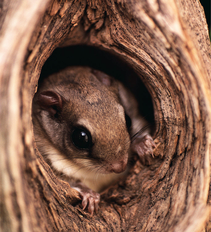|
Today’s Sunday Squirrel Spot Light star 🐿🌟is the Southern flying squirrel (Glaucomys volans). These squirrels glide through the air using a specialized skin membrane that stretches from ankle to ankle called a patagium. This allows them to leap from branches and gracefully glide through the sky to other nearby trees or down to the ground forage. Southern flying squirrels are found in Eastern North America, but are rarely seen by squirrel gazers 🐿👀because unlike the other squirrel species profiled so far, southern flying squirrels are nocturnal🌙🌲. Using their extra large eyes, these flying rodents are able to see and forage at night. Flying squirrels enjoy eating insects, bird eggs, and fruits, but their favorite meals are hickory nuts and acorns 🌰. They do not hibernate during the winter months when food is hard to find, so they have to store food for later! Southern flying squirrels are social animals and live in groups tucked inside hollowed out tree cavities, and sometimes occupy abandoned woodpecker holes. To communicate with their buddies these squirrels use ultrasonic vocalizations! Ultrasonic vocalizations are sounds so high pitched humans can not hear them. These are the same type of sounds that bats use for echolocation! I have never been lucky enough to see a Southern Flying Squirrel myself so, today’s video clip is from National Geographic's coverage of research being done on squirrel flight mechanics. Watch these tiny flying rodents glide over a football field 🏈with ease! (Neilson, 1918); (Thomas & Weigl, 1998); (Garroway, Bowman, & Wilson, 2013); (Marrant, et. al., 2013)
What is more adorable than a California ground squirrel? A baby California ground squirrel! Most California ground squirrel populations breed only once a year in the springtime, right around the time they emerge from their burrows after hibernating through the cold winter months. Excitingly, in warmer places like Southern California these squirrels tend not to hibernate and have been found to breed all year long! This is great news for Squirrel Gazer because there are a ton of cute baby squirrels running around the James Reserve where our research is being conducted! Grace is one of the resident ground squirrel mothers on the reserve. She can often be seen watching her 3 young pups foraging from the comfort of her burrow entrance. California ground squirrels moms are pregnant for about one month. Females will give birth to a litter consisting of an average 5 pups. After about 5 weeks living exclusively in their burrow, these tiny cheeky squirrels will emerge to explore the world above ground. Ground squirrels like Grace are notoriously good mothers. Rattlesnakes find squirrels to be a tasty snack and ground squirrel mothers will take big risks to protect their offspring from becoming lunch. Female ground squirrels with vulnerable offspring are more likely than other adult squirrels to participate in “anti-snake behavior”. This behavior includes wagging their tail in the air (tail flagging) to help them appear larger and harassing the snake by approaching it and kicking dirt towards it. This is an overly simplified description of a very cool and complex behavior for which there is a large body of scientific literature on. I will discuss in more detail in a future Ground Squirrel vs. Rattlesnake blog post! We do not microchip youngsters for our study to prevent unnecessary stress to them or their mothers, but that does not stop these mischievous little scurides from setting off the body heat sensors in the feeder and enjoying an afternoon snack! We don’t mind though...it makes for great squirrel snack footage! (Evans & Holdenried, 1943); (Grinnell, 1918); (Swaisgood, Rowe, & Owings, 2003) Welcome to Squirrel Gazer! My name is Amanda and I am a Ph.D. student at the University of California, Los Angeles. I spend most of my days thinking about how animals think and interact with the world. My current research project is exploring the foraging decisions of wild squirrels. One thing I have learned while working with squirrels is that a lot of people share my love for (and obsession with) squirrels! I would like to use this blog as a platform to share squirrel:
No post would be complete without an adorable photo or video of squirrels. Here, is a short video montage of a family of California ground squirrels (Spermophilus beecheyi) enjoying a meal at my custom made squirrel feeder that collects data. You can find out more about what this feeder does and how it is helping me learn about squirrel foraging behavior here. This unique species of squirrel lives underground in burrows throughout the West Coast of the United States and Baja California. One cool feature of the Cali ground squirrel is their cheek pouches! If you watch this video closely you can see that not all the squirrels are eating the seeds they find at the feeder immediately... many of them are quickly tucking their bounty in to their cheek pouches and carrying it away for later! Subscribe to receive notifications of new blog posts! You can also follow Squirrel Gazer on Instagram, Youtube, and Twitter! |
Proudly powered by Weebly





 RSS Feed
RSS Feed